Queensland Health New Payroll System: A Case Study Report
VerifiedAdded on 2022/10/31
|13
|3104
|197
Report
AI Summary
This report examines the challenges faced by Queensland Health during the implementation of a new payroll system, focusing on the impact on the Royal Brisbane and Women's Hospital. It explores the issues of outdated IT systems and their effects on business objectives, including financial losses and reputational damage. The report investigates the role of IT support, software and hardware capacities, and the functionalities of different computer systems within the healthcare environment. It highlights project management issues, such as delays and cost overruns, and discusses the importance of change management and communication. The report concludes with recommendations for successful IT system implementation, emphasizing the need for careful planning, stakeholder communication, and realistic objectives to avoid the pitfalls experienced by Queensland Health. The report also highlights the importance of software, such as human capital systems, in enhancing the efficiency of payroll processes. The analysis includes the evaluation of the payroll system's role in improving accuracy, managing employee data, and enhancing patient care.
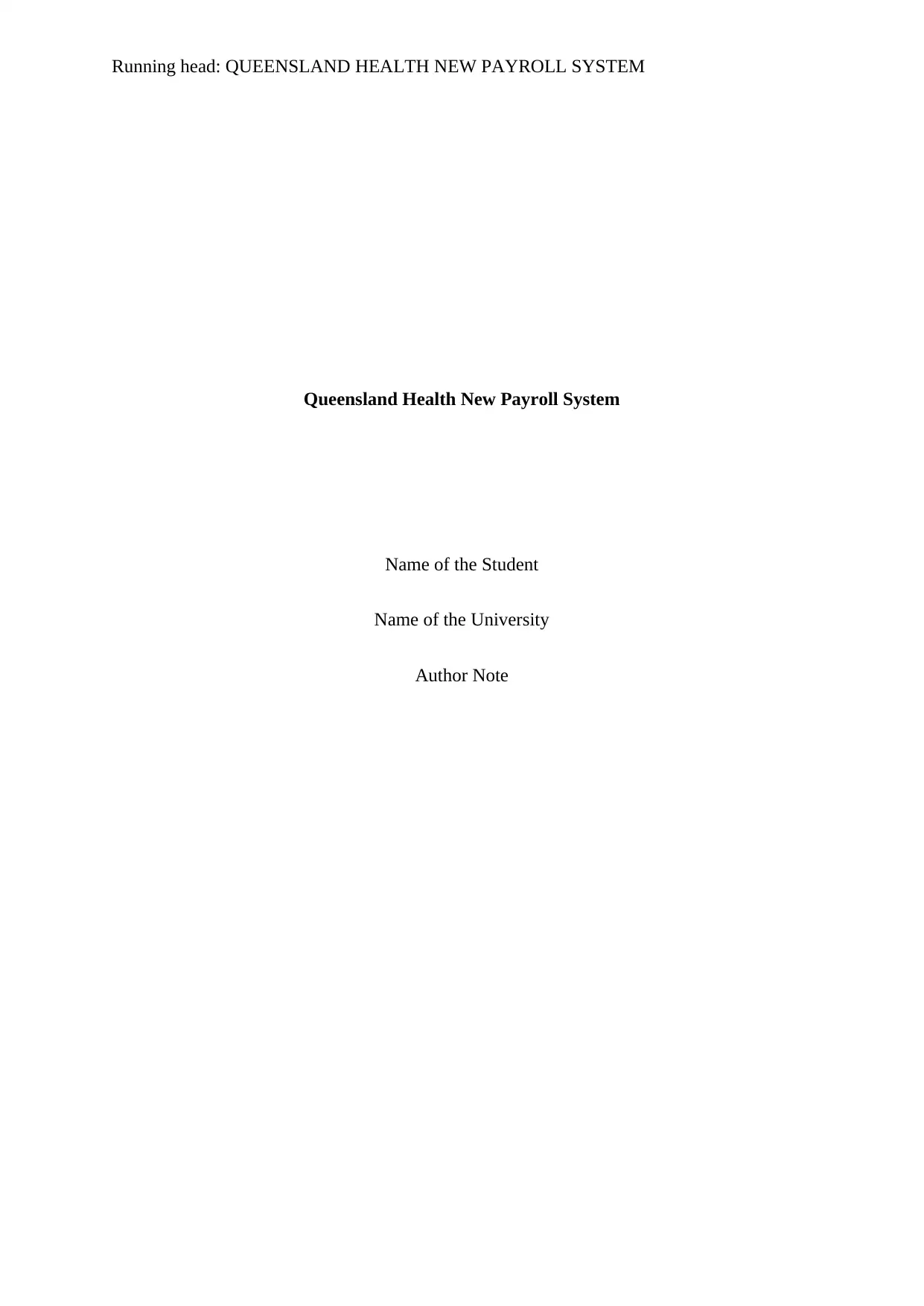
Running head: QUEENSLAND HEALTH NEW PAYROLL SYSTEM
Queensland Health New Payroll System
Name of the Student
Name of the University
Author Note
Queensland Health New Payroll System
Name of the Student
Name of the University
Author Note
Paraphrase This Document
Need a fresh take? Get an instant paraphrase of this document with our AI Paraphraser
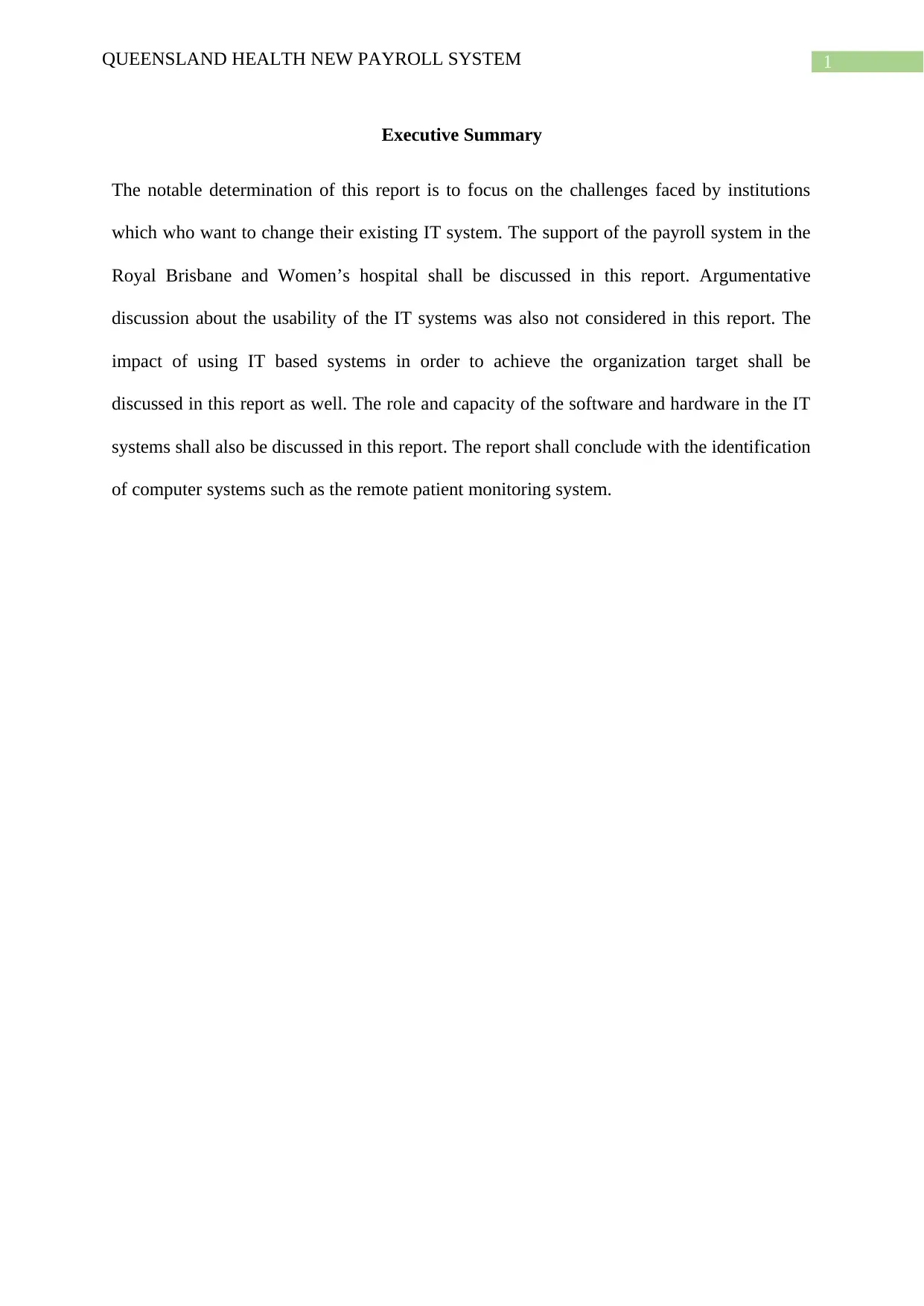
1QUEENSLAND HEALTH NEW PAYROLL SYSTEM
Executive Summary
The notable determination of this report is to focus on the challenges faced by institutions
which who want to change their existing IT system. The support of the payroll system in the
Royal Brisbane and Women’s hospital shall be discussed in this report. Argumentative
discussion about the usability of the IT systems was also not considered in this report. The
impact of using IT based systems in order to achieve the organization target shall be
discussed in this report as well. The role and capacity of the software and hardware in the IT
systems shall also be discussed in this report. The report shall conclude with the identification
of computer systems such as the remote patient monitoring system.
Executive Summary
The notable determination of this report is to focus on the challenges faced by institutions
which who want to change their existing IT system. The support of the payroll system in the
Royal Brisbane and Women’s hospital shall be discussed in this report. Argumentative
discussion about the usability of the IT systems was also not considered in this report. The
impact of using IT based systems in order to achieve the organization target shall be
discussed in this report as well. The role and capacity of the software and hardware in the IT
systems shall also be discussed in this report. The report shall conclude with the identification
of computer systems such as the remote patient monitoring system.
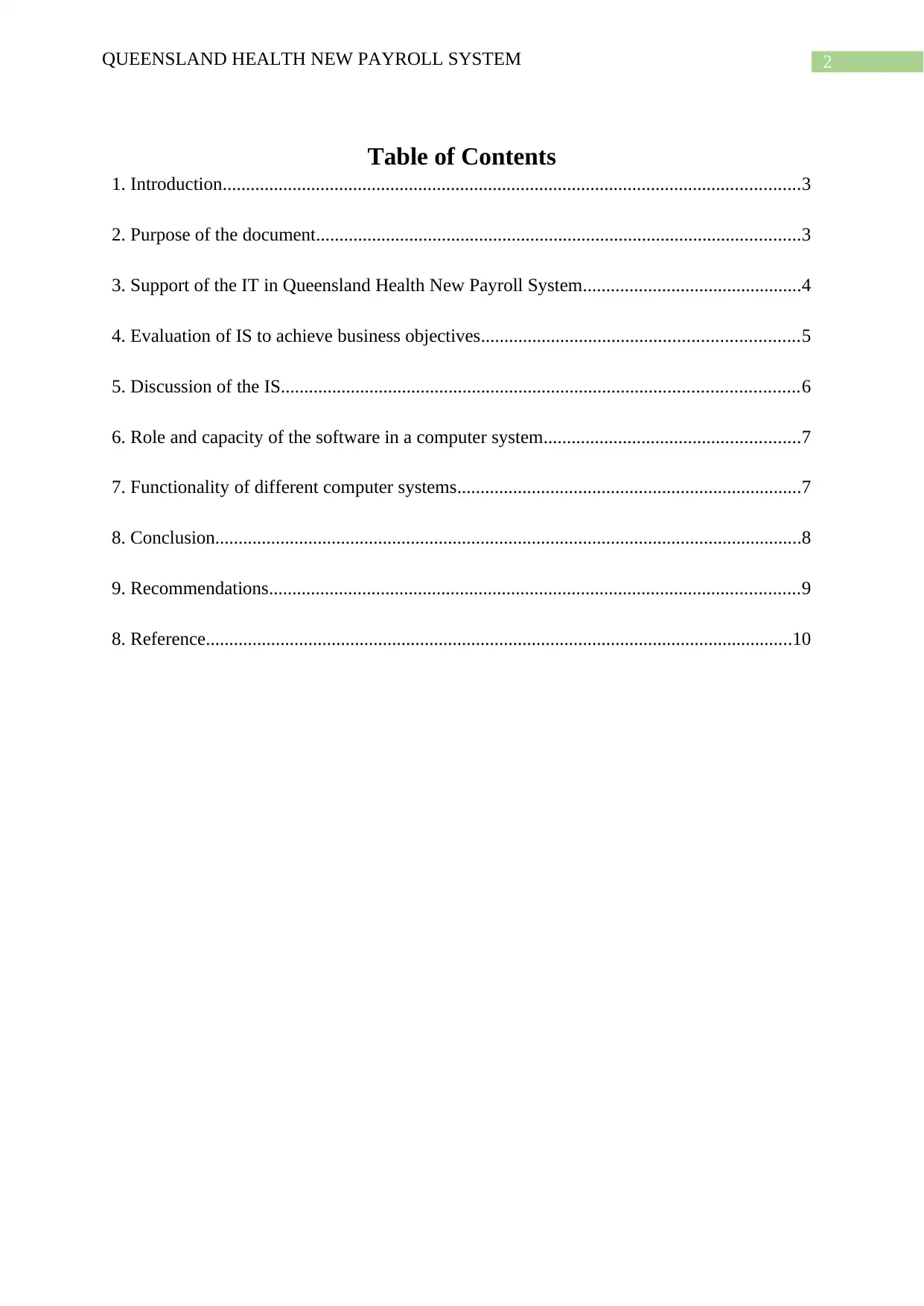
2QUEENSLAND HEALTH NEW PAYROLL SYSTEM
Table of Contents
1. Introduction............................................................................................................................3
2. Purpose of the document........................................................................................................3
3. Support of the IT in Queensland Health New Payroll System...............................................4
4. Evaluation of IS to achieve business objectives....................................................................5
5. Discussion of the IS...............................................................................................................6
6. Role and capacity of the software in a computer system.......................................................7
7. Functionality of different computer systems..........................................................................7
8. Conclusion..............................................................................................................................8
9. Recommendations..................................................................................................................9
8. Reference..............................................................................................................................10
Table of Contents
1. Introduction............................................................................................................................3
2. Purpose of the document........................................................................................................3
3. Support of the IT in Queensland Health New Payroll System...............................................4
4. Evaluation of IS to achieve business objectives....................................................................5
5. Discussion of the IS...............................................................................................................6
6. Role and capacity of the software in a computer system.......................................................7
7. Functionality of different computer systems..........................................................................7
8. Conclusion..............................................................................................................................8
9. Recommendations..................................................................................................................9
8. Reference..............................................................................................................................10
⊘ This is a preview!⊘
Do you want full access?
Subscribe today to unlock all pages.

Trusted by 1+ million students worldwide
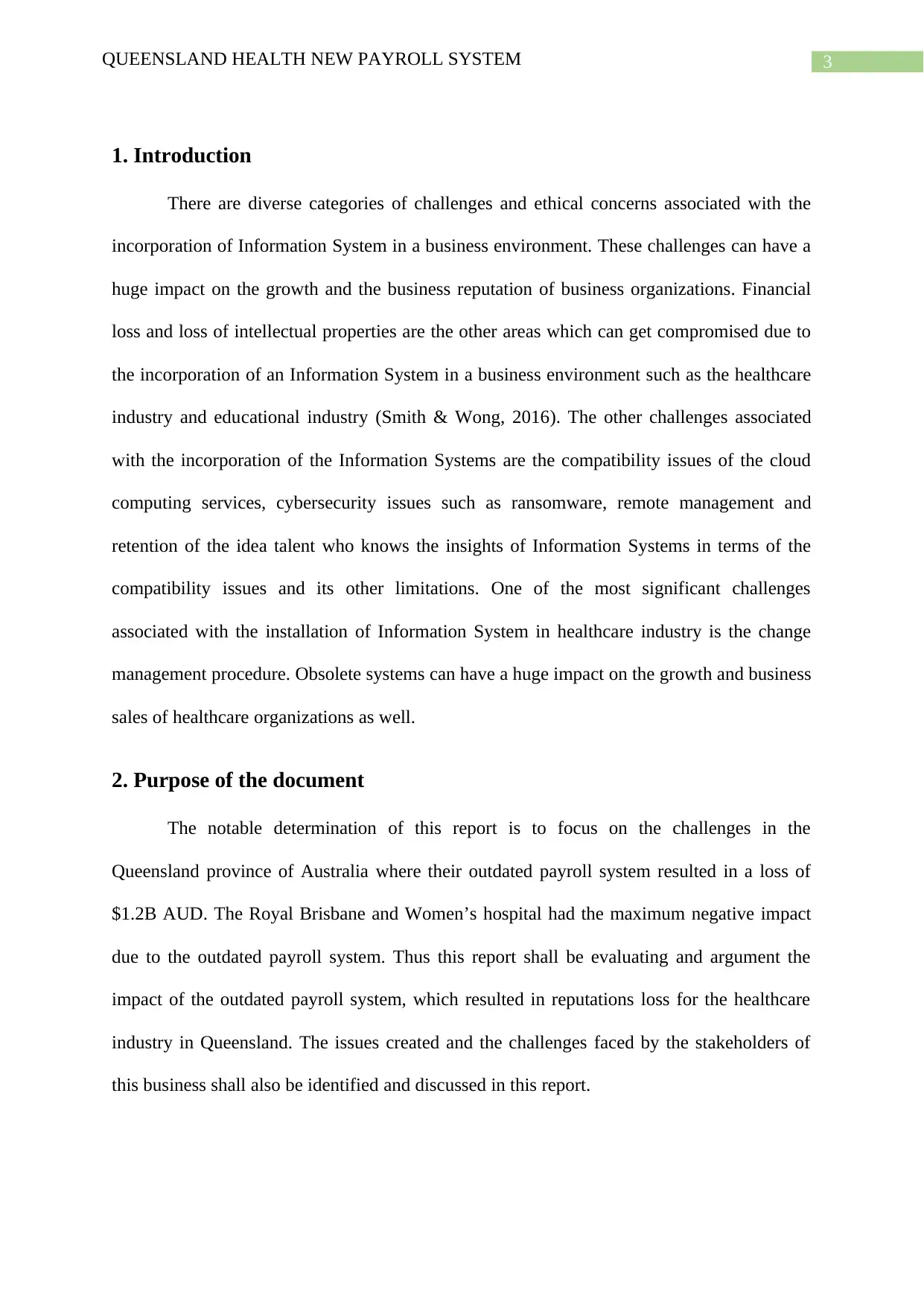
3QUEENSLAND HEALTH NEW PAYROLL SYSTEM
1. Introduction
There are diverse categories of challenges and ethical concerns associated with the
incorporation of Information System in a business environment. These challenges can have a
huge impact on the growth and the business reputation of business organizations. Financial
loss and loss of intellectual properties are the other areas which can get compromised due to
the incorporation of an Information System in a business environment such as the healthcare
industry and educational industry (Smith & Wong, 2016). The other challenges associated
with the incorporation of the Information Systems are the compatibility issues of the cloud
computing services, cybersecurity issues such as ransomware, remote management and
retention of the idea talent who knows the insights of Information Systems in terms of the
compatibility issues and its other limitations. One of the most significant challenges
associated with the installation of Information System in healthcare industry is the change
management procedure. Obsolete systems can have a huge impact on the growth and business
sales of healthcare organizations as well.
2. Purpose of the document
The notable determination of this report is to focus on the challenges in the
Queensland province of Australia where their outdated payroll system resulted in a loss of
$1.2B AUD. The Royal Brisbane and Women’s hospital had the maximum negative impact
due to the outdated payroll system. Thus this report shall be evaluating and argument the
impact of the outdated payroll system, which resulted in reputations loss for the healthcare
industry in Queensland. The issues created and the challenges faced by the stakeholders of
this business shall also be identified and discussed in this report.
1. Introduction
There are diverse categories of challenges and ethical concerns associated with the
incorporation of Information System in a business environment. These challenges can have a
huge impact on the growth and the business reputation of business organizations. Financial
loss and loss of intellectual properties are the other areas which can get compromised due to
the incorporation of an Information System in a business environment such as the healthcare
industry and educational industry (Smith & Wong, 2016). The other challenges associated
with the incorporation of the Information Systems are the compatibility issues of the cloud
computing services, cybersecurity issues such as ransomware, remote management and
retention of the idea talent who knows the insights of Information Systems in terms of the
compatibility issues and its other limitations. One of the most significant challenges
associated with the installation of Information System in healthcare industry is the change
management procedure. Obsolete systems can have a huge impact on the growth and business
sales of healthcare organizations as well.
2. Purpose of the document
The notable determination of this report is to focus on the challenges in the
Queensland province of Australia where their outdated payroll system resulted in a loss of
$1.2B AUD. The Royal Brisbane and Women’s hospital had the maximum negative impact
due to the outdated payroll system. Thus this report shall be evaluating and argument the
impact of the outdated payroll system, which resulted in reputations loss for the healthcare
industry in Queensland. The issues created and the challenges faced by the stakeholders of
this business shall also be identified and discussed in this report.
Paraphrase This Document
Need a fresh take? Get an instant paraphrase of this document with our AI Paraphraser
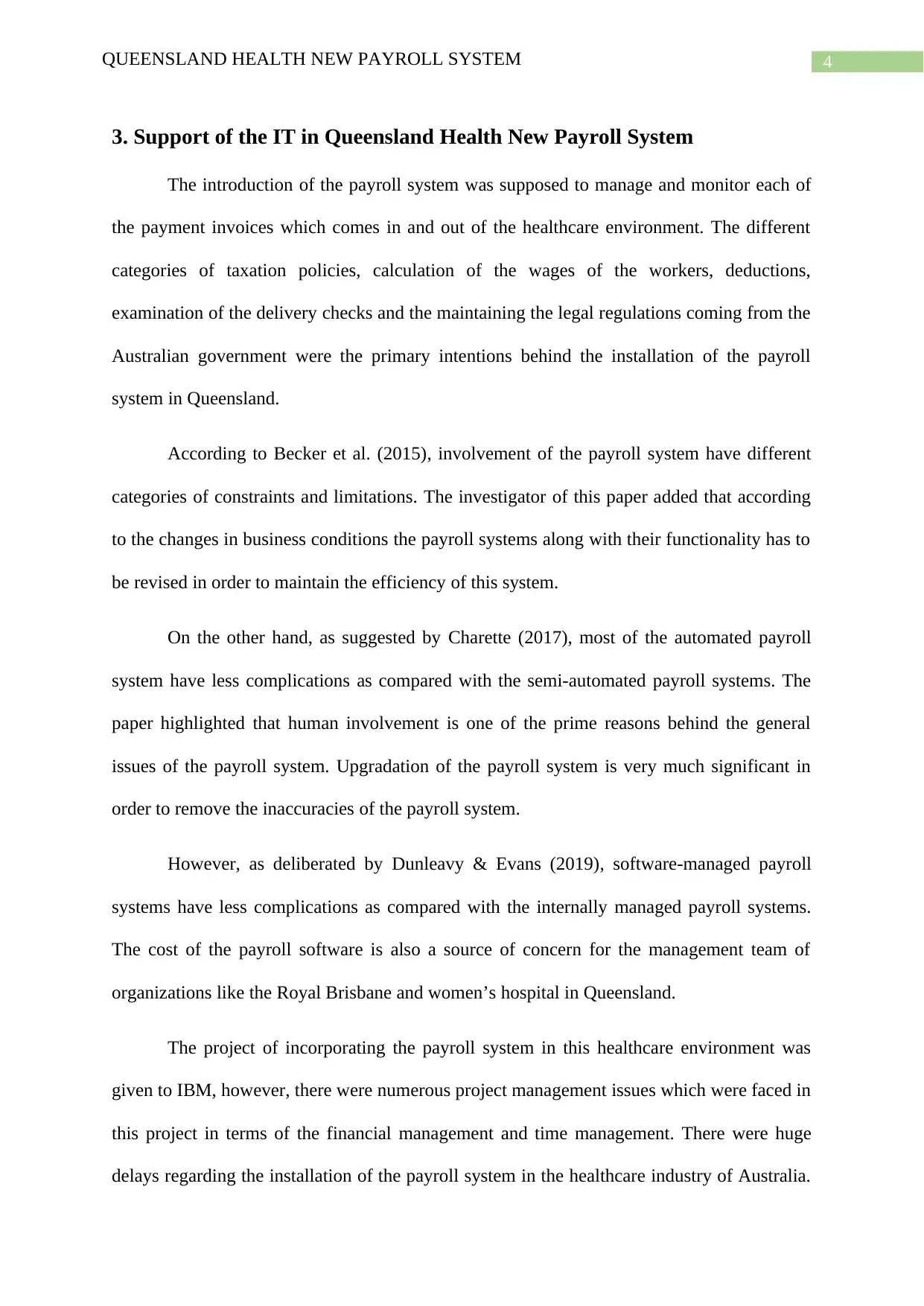
4QUEENSLAND HEALTH NEW PAYROLL SYSTEM
3. Support of the IT in Queensland Health New Payroll System
The introduction of the payroll system was supposed to manage and monitor each of
the payment invoices which comes in and out of the healthcare environment. The different
categories of taxation policies, calculation of the wages of the workers, deductions,
examination of the delivery checks and the maintaining the legal regulations coming from the
Australian government were the primary intentions behind the installation of the payroll
system in Queensland.
According to Becker et al. (2015), involvement of the payroll system have different
categories of constraints and limitations. The investigator of this paper added that according
to the changes in business conditions the payroll systems along with their functionality has to
be revised in order to maintain the efficiency of this system.
On the other hand, as suggested by Charette (2017), most of the automated payroll
system have less complications as compared with the semi-automated payroll systems. The
paper highlighted that human involvement is one of the prime reasons behind the general
issues of the payroll system. Upgradation of the payroll system is very much significant in
order to remove the inaccuracies of the payroll system.
However, as deliberated by Dunleavy & Evans (2019), software-managed payroll
systems have less complications as compared with the internally managed payroll systems.
The cost of the payroll software is also a source of concern for the management team of
organizations like the Royal Brisbane and women’s hospital in Queensland.
The project of incorporating the payroll system in this healthcare environment was
given to IBM, however, there were numerous project management issues which were faced in
this project in terms of the financial management and time management. There were huge
delays regarding the installation of the payroll system in the healthcare industry of Australia.
3. Support of the IT in Queensland Health New Payroll System
The introduction of the payroll system was supposed to manage and monitor each of
the payment invoices which comes in and out of the healthcare environment. The different
categories of taxation policies, calculation of the wages of the workers, deductions,
examination of the delivery checks and the maintaining the legal regulations coming from the
Australian government were the primary intentions behind the installation of the payroll
system in Queensland.
According to Becker et al. (2015), involvement of the payroll system have different
categories of constraints and limitations. The investigator of this paper added that according
to the changes in business conditions the payroll systems along with their functionality has to
be revised in order to maintain the efficiency of this system.
On the other hand, as suggested by Charette (2017), most of the automated payroll
system have less complications as compared with the semi-automated payroll systems. The
paper highlighted that human involvement is one of the prime reasons behind the general
issues of the payroll system. Upgradation of the payroll system is very much significant in
order to remove the inaccuracies of the payroll system.
However, as deliberated by Dunleavy & Evans (2019), software-managed payroll
systems have less complications as compared with the internally managed payroll systems.
The cost of the payroll software is also a source of concern for the management team of
organizations like the Royal Brisbane and women’s hospital in Queensland.
The project of incorporating the payroll system in this healthcare environment was
given to IBM, however, there were numerous project management issues which were faced in
this project in terms of the financial management and time management. There were huge
delays regarding the installation of the payroll system in the healthcare industry of Australia.
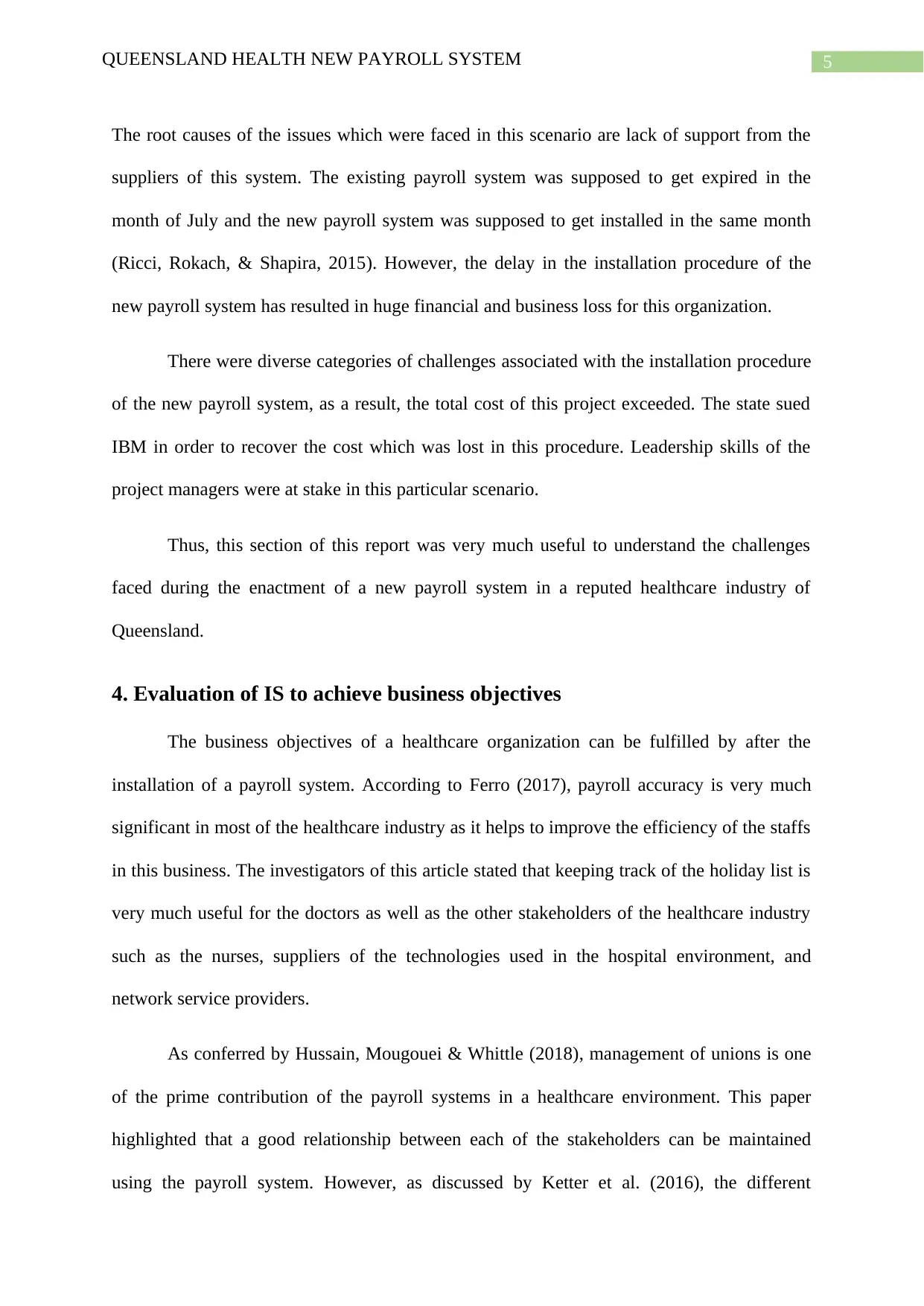
5QUEENSLAND HEALTH NEW PAYROLL SYSTEM
The root causes of the issues which were faced in this scenario are lack of support from the
suppliers of this system. The existing payroll system was supposed to get expired in the
month of July and the new payroll system was supposed to get installed in the same month
(Ricci, Rokach, & Shapira, 2015). However, the delay in the installation procedure of the
new payroll system has resulted in huge financial and business loss for this organization.
There were diverse categories of challenges associated with the installation procedure
of the new payroll system, as a result, the total cost of this project exceeded. The state sued
IBM in order to recover the cost which was lost in this procedure. Leadership skills of the
project managers were at stake in this particular scenario.
Thus, this section of this report was very much useful to understand the challenges
faced during the enactment of a new payroll system in a reputed healthcare industry of
Queensland.
4. Evaluation of IS to achieve business objectives
The business objectives of a healthcare organization can be fulfilled by after the
installation of a payroll system. According to Ferro (2017), payroll accuracy is very much
significant in most of the healthcare industry as it helps to improve the efficiency of the staffs
in this business. The investigators of this article stated that keeping track of the holiday list is
very much useful for the doctors as well as the other stakeholders of the healthcare industry
such as the nurses, suppliers of the technologies used in the hospital environment, and
network service providers.
As conferred by Hussain, Mougouei & Whittle (2018), management of unions is one
of the prime contribution of the payroll systems in a healthcare environment. This paper
highlighted that a good relationship between each of the stakeholders can be maintained
using the payroll system. However, as discussed by Ketter et al. (2016), the different
The root causes of the issues which were faced in this scenario are lack of support from the
suppliers of this system. The existing payroll system was supposed to get expired in the
month of July and the new payroll system was supposed to get installed in the same month
(Ricci, Rokach, & Shapira, 2015). However, the delay in the installation procedure of the
new payroll system has resulted in huge financial and business loss for this organization.
There were diverse categories of challenges associated with the installation procedure
of the new payroll system, as a result, the total cost of this project exceeded. The state sued
IBM in order to recover the cost which was lost in this procedure. Leadership skills of the
project managers were at stake in this particular scenario.
Thus, this section of this report was very much useful to understand the challenges
faced during the enactment of a new payroll system in a reputed healthcare industry of
Queensland.
4. Evaluation of IS to achieve business objectives
The business objectives of a healthcare organization can be fulfilled by after the
installation of a payroll system. According to Ferro (2017), payroll accuracy is very much
significant in most of the healthcare industry as it helps to improve the efficiency of the staffs
in this business. The investigators of this article stated that keeping track of the holiday list is
very much useful for the doctors as well as the other stakeholders of the healthcare industry
such as the nurses, suppliers of the technologies used in the hospital environment, and
network service providers.
As conferred by Hussain, Mougouei & Whittle (2018), management of unions is one
of the prime contribution of the payroll systems in a healthcare environment. This paper
highlighted that a good relationship between each of the stakeholders can be maintained
using the payroll system. However, as discussed by Ketter et al. (2016), the different
⊘ This is a preview!⊘
Do you want full access?
Subscribe today to unlock all pages.

Trusted by 1+ million students worldwide
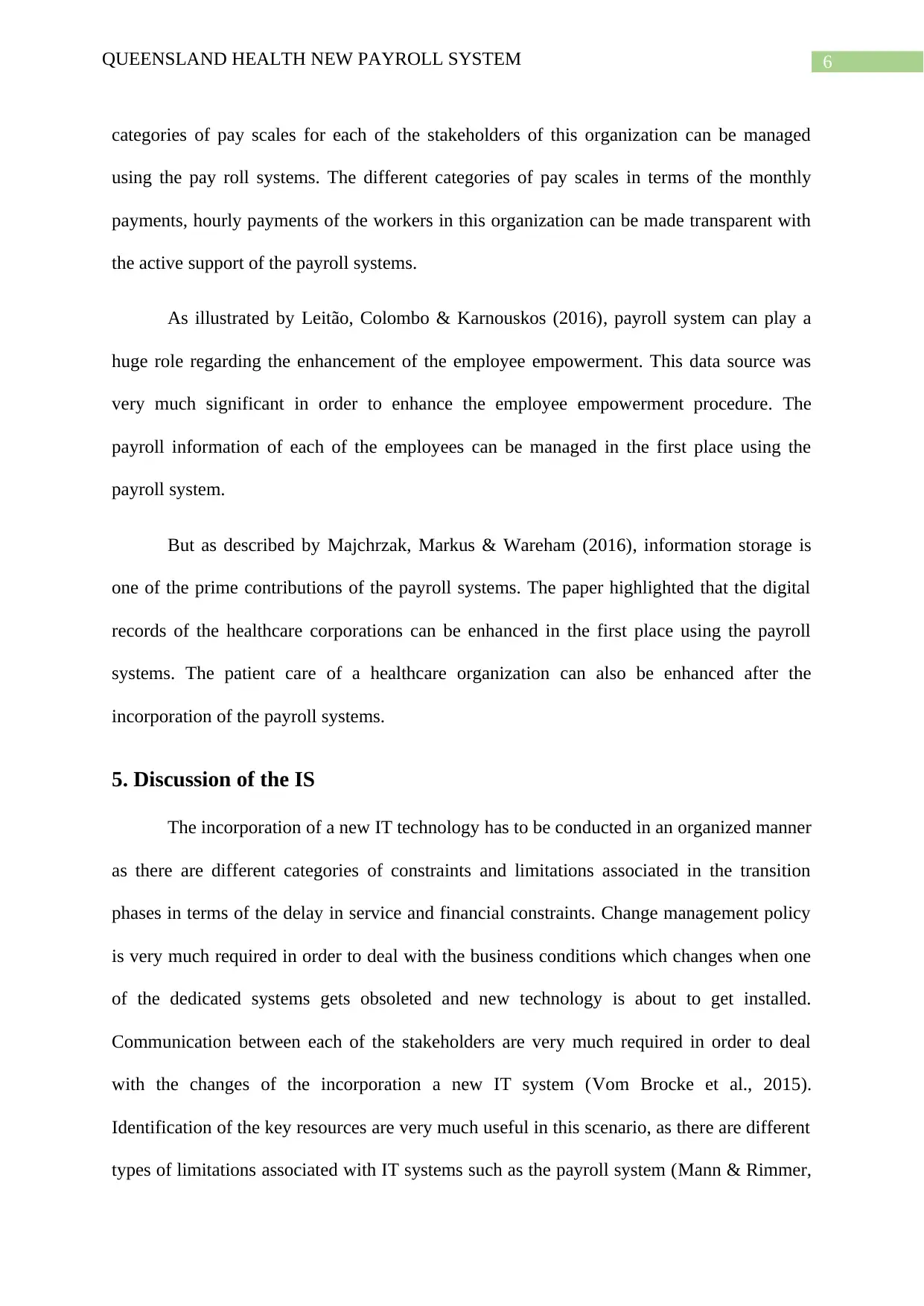
6QUEENSLAND HEALTH NEW PAYROLL SYSTEM
categories of pay scales for each of the stakeholders of this organization can be managed
using the pay roll systems. The different categories of pay scales in terms of the monthly
payments, hourly payments of the workers in this organization can be made transparent with
the active support of the payroll systems.
As illustrated by Leitão, Colombo & Karnouskos (2016), payroll system can play a
huge role regarding the enhancement of the employee empowerment. This data source was
very much significant in order to enhance the employee empowerment procedure. The
payroll information of each of the employees can be managed in the first place using the
payroll system.
But as described by Majchrzak, Markus & Wareham (2016), information storage is
one of the prime contributions of the payroll systems. The paper highlighted that the digital
records of the healthcare corporations can be enhanced in the first place using the payroll
systems. The patient care of a healthcare organization can also be enhanced after the
incorporation of the payroll systems.
5. Discussion of the IS
The incorporation of a new IT technology has to be conducted in an organized manner
as there are different categories of constraints and limitations associated in the transition
phases in terms of the delay in service and financial constraints. Change management policy
is very much required in order to deal with the business conditions which changes when one
of the dedicated systems gets obsoleted and new technology is about to get installed.
Communication between each of the stakeholders are very much required in order to deal
with the changes of the incorporation a new IT system (Vom Brocke et al., 2015).
Identification of the key resources are very much useful in this scenario, as there are different
types of limitations associated with IT systems such as the payroll system (Mann & Rimmer,
categories of pay scales for each of the stakeholders of this organization can be managed
using the pay roll systems. The different categories of pay scales in terms of the monthly
payments, hourly payments of the workers in this organization can be made transparent with
the active support of the payroll systems.
As illustrated by Leitão, Colombo & Karnouskos (2016), payroll system can play a
huge role regarding the enhancement of the employee empowerment. This data source was
very much significant in order to enhance the employee empowerment procedure. The
payroll information of each of the employees can be managed in the first place using the
payroll system.
But as described by Majchrzak, Markus & Wareham (2016), information storage is
one of the prime contributions of the payroll systems. The paper highlighted that the digital
records of the healthcare corporations can be enhanced in the first place using the payroll
systems. The patient care of a healthcare organization can also be enhanced after the
incorporation of the payroll systems.
5. Discussion of the IS
The incorporation of a new IT technology has to be conducted in an organized manner
as there are different categories of constraints and limitations associated in the transition
phases in terms of the delay in service and financial constraints. Change management policy
is very much required in order to deal with the business conditions which changes when one
of the dedicated systems gets obsoleted and new technology is about to get installed.
Communication between each of the stakeholders are very much required in order to deal
with the changes of the incorporation a new IT system (Vom Brocke et al., 2015).
Identification of the key resources are very much useful in this scenario, as there are different
types of limitations associated with IT systems such as the payroll system (Mann & Rimmer,
Paraphrase This Document
Need a fresh take? Get an instant paraphrase of this document with our AI Paraphraser
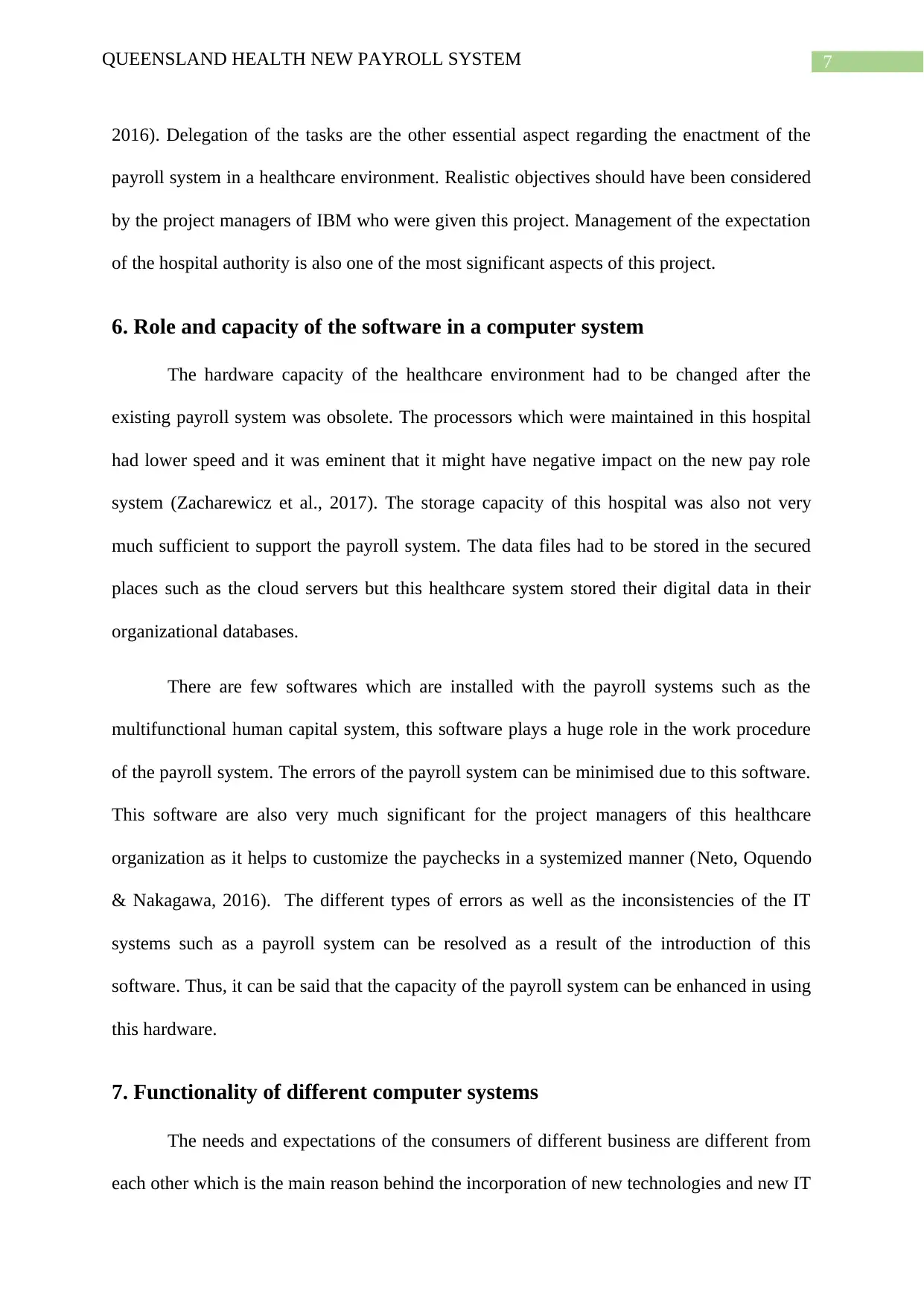
7QUEENSLAND HEALTH NEW PAYROLL SYSTEM
2016). Delegation of the tasks are the other essential aspect regarding the enactment of the
payroll system in a healthcare environment. Realistic objectives should have been considered
by the project managers of IBM who were given this project. Management of the expectation
of the hospital authority is also one of the most significant aspects of this project.
6. Role and capacity of the software in a computer system
The hardware capacity of the healthcare environment had to be changed after the
existing payroll system was obsolete. The processors which were maintained in this hospital
had lower speed and it was eminent that it might have negative impact on the new pay role
system (Zacharewicz et al., 2017). The storage capacity of this hospital was also not very
much sufficient to support the payroll system. The data files had to be stored in the secured
places such as the cloud servers but this healthcare system stored their digital data in their
organizational databases.
There are few softwares which are installed with the payroll systems such as the
multifunctional human capital system, this software plays a huge role in the work procedure
of the payroll system. The errors of the payroll system can be minimised due to this software.
This software are also very much significant for the project managers of this healthcare
organization as it helps to customize the paychecks in a systemized manner (Neto, Oquendo
& Nakagawa, 2016). The different types of errors as well as the inconsistencies of the IT
systems such as a payroll system can be resolved as a result of the introduction of this
software. Thus, it can be said that the capacity of the payroll system can be enhanced in using
this hardware.
7. Functionality of different computer systems
The needs and expectations of the consumers of different business are different from
each other which is the main reason behind the incorporation of new technologies and new IT
2016). Delegation of the tasks are the other essential aspect regarding the enactment of the
payroll system in a healthcare environment. Realistic objectives should have been considered
by the project managers of IBM who were given this project. Management of the expectation
of the hospital authority is also one of the most significant aspects of this project.
6. Role and capacity of the software in a computer system
The hardware capacity of the healthcare environment had to be changed after the
existing payroll system was obsolete. The processors which were maintained in this hospital
had lower speed and it was eminent that it might have negative impact on the new pay role
system (Zacharewicz et al., 2017). The storage capacity of this hospital was also not very
much sufficient to support the payroll system. The data files had to be stored in the secured
places such as the cloud servers but this healthcare system stored their digital data in their
organizational databases.
There are few softwares which are installed with the payroll systems such as the
multifunctional human capital system, this software plays a huge role in the work procedure
of the payroll system. The errors of the payroll system can be minimised due to this software.
This software are also very much significant for the project managers of this healthcare
organization as it helps to customize the paychecks in a systemized manner (Neto, Oquendo
& Nakagawa, 2016). The different types of errors as well as the inconsistencies of the IT
systems such as a payroll system can be resolved as a result of the introduction of this
software. Thus, it can be said that the capacity of the payroll system can be enhanced in using
this hardware.
7. Functionality of different computer systems
The needs and expectations of the consumers of different business are different from
each other which is the main reason behind the incorporation of new technologies and new IT
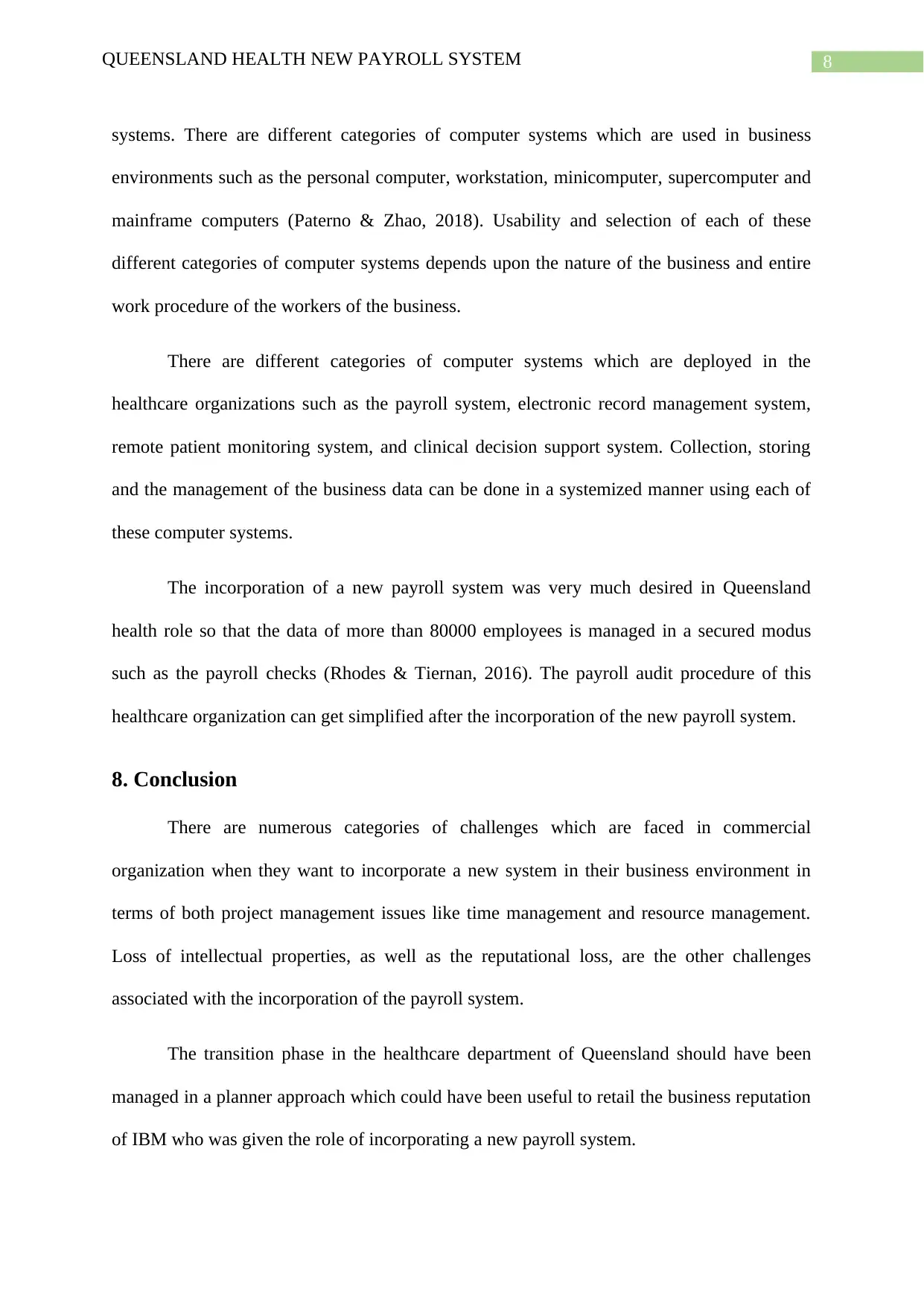
8QUEENSLAND HEALTH NEW PAYROLL SYSTEM
systems. There are different categories of computer systems which are used in business
environments such as the personal computer, workstation, minicomputer, supercomputer and
mainframe computers (Paterno & Zhao, 2018). Usability and selection of each of these
different categories of computer systems depends upon the nature of the business and entire
work procedure of the workers of the business.
There are different categories of computer systems which are deployed in the
healthcare organizations such as the payroll system, electronic record management system,
remote patient monitoring system, and clinical decision support system. Collection, storing
and the management of the business data can be done in a systemized manner using each of
these computer systems.
The incorporation of a new payroll system was very much desired in Queensland
health role so that the data of more than 80000 employees is managed in a secured modus
such as the payroll checks (Rhodes & Tiernan, 2016). The payroll audit procedure of this
healthcare organization can get simplified after the incorporation of the new payroll system.
8. Conclusion
There are numerous categories of challenges which are faced in commercial
organization when they want to incorporate a new system in their business environment in
terms of both project management issues like time management and resource management.
Loss of intellectual properties, as well as the reputational loss, are the other challenges
associated with the incorporation of the payroll system.
The transition phase in the healthcare department of Queensland should have been
managed in a planner approach which could have been useful to retail the business reputation
of IBM who was given the role of incorporating a new payroll system.
systems. There are different categories of computer systems which are used in business
environments such as the personal computer, workstation, minicomputer, supercomputer and
mainframe computers (Paterno & Zhao, 2018). Usability and selection of each of these
different categories of computer systems depends upon the nature of the business and entire
work procedure of the workers of the business.
There are different categories of computer systems which are deployed in the
healthcare organizations such as the payroll system, electronic record management system,
remote patient monitoring system, and clinical decision support system. Collection, storing
and the management of the business data can be done in a systemized manner using each of
these computer systems.
The incorporation of a new payroll system was very much desired in Queensland
health role so that the data of more than 80000 employees is managed in a secured modus
such as the payroll checks (Rhodes & Tiernan, 2016). The payroll audit procedure of this
healthcare organization can get simplified after the incorporation of the new payroll system.
8. Conclusion
There are numerous categories of challenges which are faced in commercial
organization when they want to incorporate a new system in their business environment in
terms of both project management issues like time management and resource management.
Loss of intellectual properties, as well as the reputational loss, are the other challenges
associated with the incorporation of the payroll system.
The transition phase in the healthcare department of Queensland should have been
managed in a planner approach which could have been useful to retail the business reputation
of IBM who was given the role of incorporating a new payroll system.
⊘ This is a preview!⊘
Do you want full access?
Subscribe today to unlock all pages.

Trusted by 1+ million students worldwide
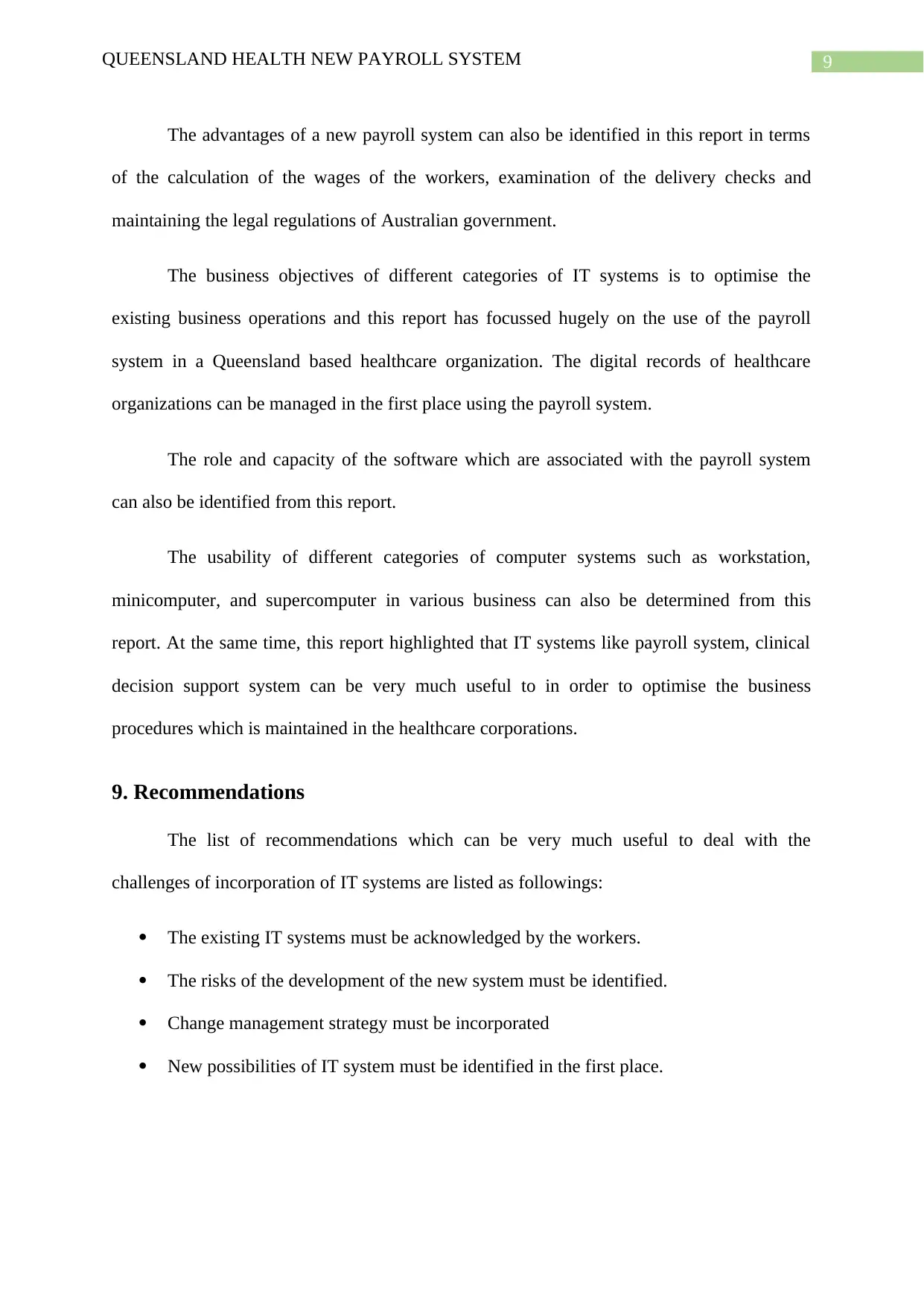
9QUEENSLAND HEALTH NEW PAYROLL SYSTEM
The advantages of a new payroll system can also be identified in this report in terms
of the calculation of the wages of the workers, examination of the delivery checks and
maintaining the legal regulations of Australian government.
The business objectives of different categories of IT systems is to optimise the
existing business operations and this report has focussed hugely on the use of the payroll
system in a Queensland based healthcare organization. The digital records of healthcare
organizations can be managed in the first place using the payroll system.
The role and capacity of the software which are associated with the payroll system
can also be identified from this report.
The usability of different categories of computer systems such as workstation,
minicomputer, and supercomputer in various business can also be determined from this
report. At the same time, this report highlighted that IT systems like payroll system, clinical
decision support system can be very much useful to in order to optimise the business
procedures which is maintained in the healthcare corporations.
9. Recommendations
The list of recommendations which can be very much useful to deal with the
challenges of incorporation of IT systems are listed as followings:
The existing IT systems must be acknowledged by the workers.
The risks of the development of the new system must be identified.
Change management strategy must be incorporated
New possibilities of IT system must be identified in the first place.
The advantages of a new payroll system can also be identified in this report in terms
of the calculation of the wages of the workers, examination of the delivery checks and
maintaining the legal regulations of Australian government.
The business objectives of different categories of IT systems is to optimise the
existing business operations and this report has focussed hugely on the use of the payroll
system in a Queensland based healthcare organization. The digital records of healthcare
organizations can be managed in the first place using the payroll system.
The role and capacity of the software which are associated with the payroll system
can also be identified from this report.
The usability of different categories of computer systems such as workstation,
minicomputer, and supercomputer in various business can also be determined from this
report. At the same time, this report highlighted that IT systems like payroll system, clinical
decision support system can be very much useful to in order to optimise the business
procedures which is maintained in the healthcare corporations.
9. Recommendations
The list of recommendations which can be very much useful to deal with the
challenges of incorporation of IT systems are listed as followings:
The existing IT systems must be acknowledged by the workers.
The risks of the development of the new system must be identified.
Change management strategy must be incorporated
New possibilities of IT system must be identified in the first place.
Paraphrase This Document
Need a fresh take? Get an instant paraphrase of this document with our AI Paraphraser
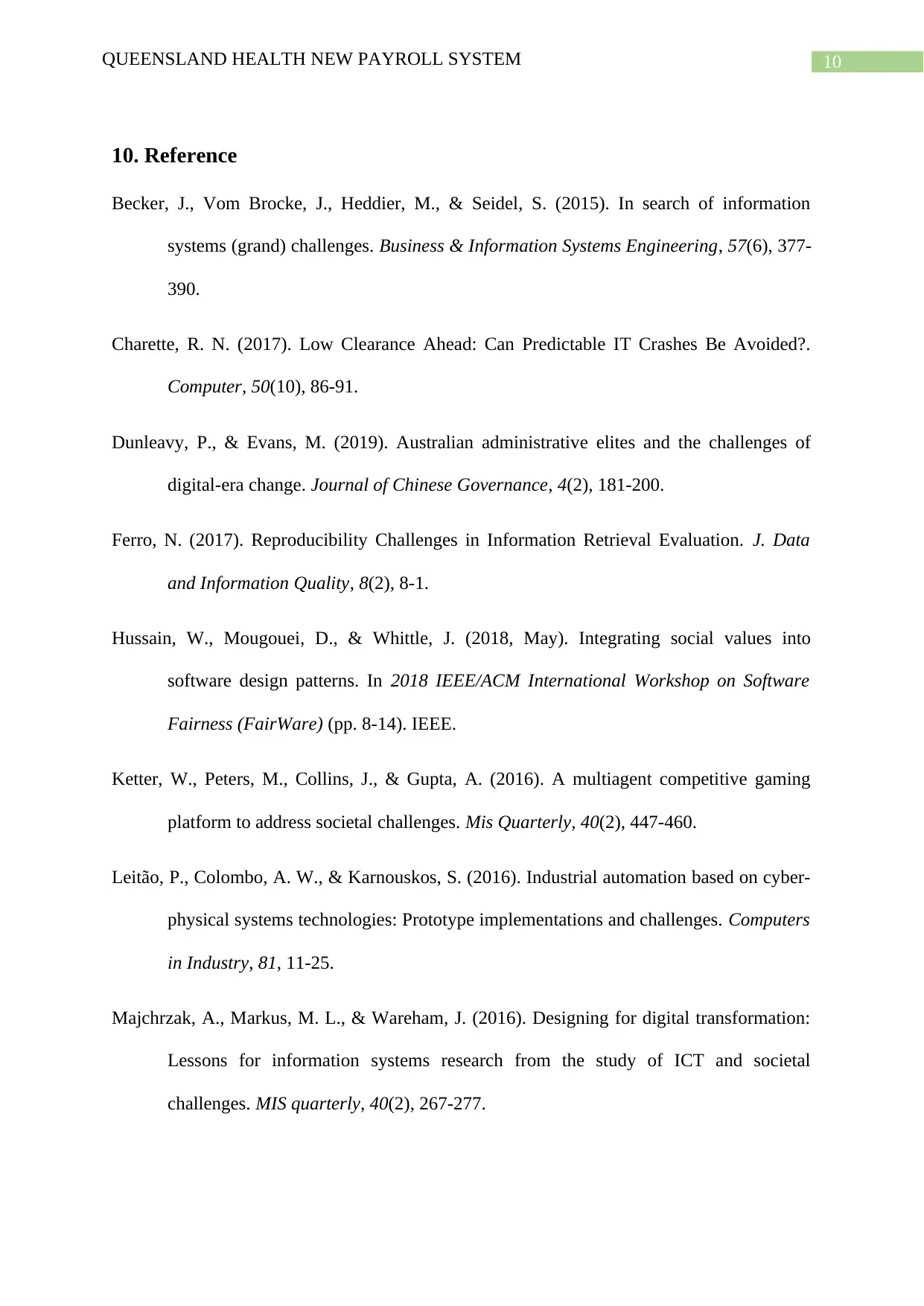
10QUEENSLAND HEALTH NEW PAYROLL SYSTEM
10. Reference
Becker, J., Vom Brocke, J., Heddier, M., & Seidel, S. (2015). In search of information
systems (grand) challenges. Business & Information Systems Engineering, 57(6), 377-
390.
Charette, R. N. (2017). Low Clearance Ahead: Can Predictable IT Crashes Be Avoided?.
Computer, 50(10), 86-91.
Dunleavy, P., & Evans, M. (2019). Australian administrative elites and the challenges of
digital-era change. Journal of Chinese Governance, 4(2), 181-200.
Ferro, N. (2017). Reproducibility Challenges in Information Retrieval Evaluation. J. Data
and Information Quality, 8(2), 8-1.
Hussain, W., Mougouei, D., & Whittle, J. (2018, May). Integrating social values into
software design patterns. In 2018 IEEE/ACM International Workshop on Software
Fairness (FairWare) (pp. 8-14). IEEE.
Ketter, W., Peters, M., Collins, J., & Gupta, A. (2016). A multiagent competitive gaming
platform to address societal challenges. Mis Quarterly, 40(2), 447-460.
Leitão, P., Colombo, A. W., & Karnouskos, S. (2016). Industrial automation based on cyber-
physical systems technologies: Prototype implementations and challenges. Computers
in Industry, 81, 11-25.
Majchrzak, A., Markus, M. L., & Wareham, J. (2016). Designing for digital transformation:
Lessons for information systems research from the study of ICT and societal
challenges. MIS quarterly, 40(2), 267-277.
10. Reference
Becker, J., Vom Brocke, J., Heddier, M., & Seidel, S. (2015). In search of information
systems (grand) challenges. Business & Information Systems Engineering, 57(6), 377-
390.
Charette, R. N. (2017). Low Clearance Ahead: Can Predictable IT Crashes Be Avoided?.
Computer, 50(10), 86-91.
Dunleavy, P., & Evans, M. (2019). Australian administrative elites and the challenges of
digital-era change. Journal of Chinese Governance, 4(2), 181-200.
Ferro, N. (2017). Reproducibility Challenges in Information Retrieval Evaluation. J. Data
and Information Quality, 8(2), 8-1.
Hussain, W., Mougouei, D., & Whittle, J. (2018, May). Integrating social values into
software design patterns. In 2018 IEEE/ACM International Workshop on Software
Fairness (FairWare) (pp. 8-14). IEEE.
Ketter, W., Peters, M., Collins, J., & Gupta, A. (2016). A multiagent competitive gaming
platform to address societal challenges. Mis Quarterly, 40(2), 447-460.
Leitão, P., Colombo, A. W., & Karnouskos, S. (2016). Industrial automation based on cyber-
physical systems technologies: Prototype implementations and challenges. Computers
in Industry, 81, 11-25.
Majchrzak, A., Markus, M. L., & Wareham, J. (2016). Designing for digital transformation:
Lessons for information systems research from the study of ICT and societal
challenges. MIS quarterly, 40(2), 267-277.
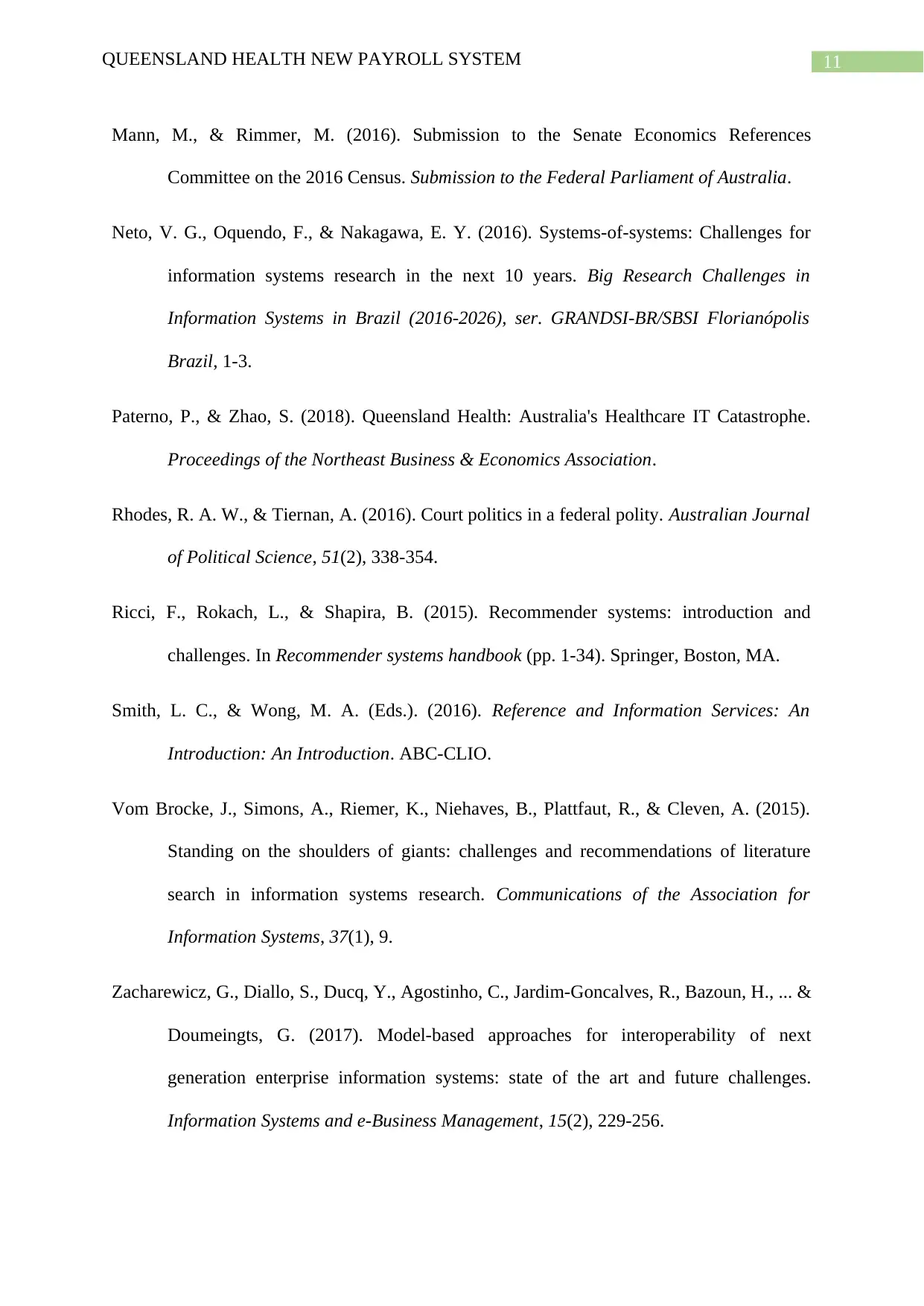
11QUEENSLAND HEALTH NEW PAYROLL SYSTEM
Mann, M., & Rimmer, M. (2016). Submission to the Senate Economics References
Committee on the 2016 Census. Submission to the Federal Parliament of Australia.
Neto, V. G., Oquendo, F., & Nakagawa, E. Y. (2016). Systems-of-systems: Challenges for
information systems research in the next 10 years. Big Research Challenges in
Information Systems in Brazil (2016-2026), ser. GRANDSI-BR/SBSI Florianópolis
Brazil, 1-3.
Paterno, P., & Zhao, S. (2018). Queensland Health: Australia's Healthcare IT Catastrophe.
Proceedings of the Northeast Business & Economics Association.
Rhodes, R. A. W., & Tiernan, A. (2016). Court politics in a federal polity. Australian Journal
of Political Science, 51(2), 338-354.
Ricci, F., Rokach, L., & Shapira, B. (2015). Recommender systems: introduction and
challenges. In Recommender systems handbook (pp. 1-34). Springer, Boston, MA.
Smith, L. C., & Wong, M. A. (Eds.). (2016). Reference and Information Services: An
Introduction: An Introduction. ABC-CLIO.
Vom Brocke, J., Simons, A., Riemer, K., Niehaves, B., Plattfaut, R., & Cleven, A. (2015).
Standing on the shoulders of giants: challenges and recommendations of literature
search in information systems research. Communications of the Association for
Information Systems, 37(1), 9.
Zacharewicz, G., Diallo, S., Ducq, Y., Agostinho, C., Jardim-Goncalves, R., Bazoun, H., ... &
Doumeingts, G. (2017). Model-based approaches for interoperability of next
generation enterprise information systems: state of the art and future challenges.
Information Systems and e-Business Management, 15(2), 229-256.
Mann, M., & Rimmer, M. (2016). Submission to the Senate Economics References
Committee on the 2016 Census. Submission to the Federal Parliament of Australia.
Neto, V. G., Oquendo, F., & Nakagawa, E. Y. (2016). Systems-of-systems: Challenges for
information systems research in the next 10 years. Big Research Challenges in
Information Systems in Brazil (2016-2026), ser. GRANDSI-BR/SBSI Florianópolis
Brazil, 1-3.
Paterno, P., & Zhao, S. (2018). Queensland Health: Australia's Healthcare IT Catastrophe.
Proceedings of the Northeast Business & Economics Association.
Rhodes, R. A. W., & Tiernan, A. (2016). Court politics in a federal polity. Australian Journal
of Political Science, 51(2), 338-354.
Ricci, F., Rokach, L., & Shapira, B. (2015). Recommender systems: introduction and
challenges. In Recommender systems handbook (pp. 1-34). Springer, Boston, MA.
Smith, L. C., & Wong, M. A. (Eds.). (2016). Reference and Information Services: An
Introduction: An Introduction. ABC-CLIO.
Vom Brocke, J., Simons, A., Riemer, K., Niehaves, B., Plattfaut, R., & Cleven, A. (2015).
Standing on the shoulders of giants: challenges and recommendations of literature
search in information systems research. Communications of the Association for
Information Systems, 37(1), 9.
Zacharewicz, G., Diallo, S., Ducq, Y., Agostinho, C., Jardim-Goncalves, R., Bazoun, H., ... &
Doumeingts, G. (2017). Model-based approaches for interoperability of next
generation enterprise information systems: state of the art and future challenges.
Information Systems and e-Business Management, 15(2), 229-256.
⊘ This is a preview!⊘
Do you want full access?
Subscribe today to unlock all pages.

Trusted by 1+ million students worldwide
1 out of 13
Related Documents
Your All-in-One AI-Powered Toolkit for Academic Success.
+13062052269
info@desklib.com
Available 24*7 on WhatsApp / Email
![[object Object]](/_next/static/media/star-bottom.7253800d.svg)
Unlock your academic potential
Copyright © 2020–2025 A2Z Services. All Rights Reserved. Developed and managed by ZUCOL.





